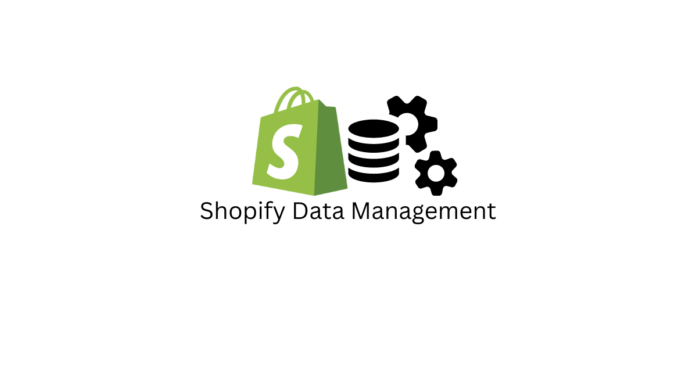Last updated - January 4, 2024
Shopify is a widely used e-commerce platform that enables merchants to create and manage their online stores. One critical aspect of managing an online store on Shopify is product data management. This involves creating, organizing, and maintaining product information such as product descriptions, pricing, inventory levels, images, and other relevant data.
Effectively managing product related data is vital for the success of an online store. Poor management can lead to inaccurate product information, stock-outs, slow page load times, and frustrated customers. In contrast, well-managed product data can enhance the user experience, increase sales, and improve customer satisfaction.
If one lacks product data management skills, a Shopify development business may be helpful. Such organizations have vast experience managing product data and may provide full solutions for smooth and effective operations. Therefore, if you’re unsure how to manage product data, think about hiring a Shopify development company.


In this post, we will cover some essential aspects of Shopify product data management, including:
- Product Catalog Structure – how to enhance your store’s navigation and searchability by organizing and structuring your product catalog.
- Product Data Management Best Practices – essential pointers for keeping all product information (price, description, image, and stock levels) current and correct.
- Inventory Management – how to maintain tabs on stock, prevent shortages, and make the most of inventory management software to guarantee continuous product availability.
- Product Optimization – ways to increase your store’s exposure on the web by utilizing search engine optimization (SEO) strategies and product information.
- Product Data Migration – how to easily transfer your store’s data from another platform to Shopify without losing any information in the process.
In general, proficient management of product data holds paramount importance for every Shopify store. Merchants can optimize their product management processes, improve the customer experience, and increase their online sales by adhering to industry best practices and leveraging available tools and features.
Understanding Shopify Product Data


Shopify product data comprises various components that merchants must manage to ensure an accurate and optimized product catalog. Some essential product data components include:
- Product Titles – It is recommended to choose a product name that is descriptive and includes relevant keywords to enhance its visibility.
- Product Descriptions – Please provide detailed information regarding the product, that includes its features, benefits, and specifications.
- Product SKUs – Each product is assigned a unique identifier for easier inventory management and sales tracking.
- Product Images – We require images of superior quality which effectively highlight the product’s appearance and features.
- Product Variants – Multiple variations of a product, including but not limited to varying sizes, colors, or materials.
- Product Pricing – Please provide information regarding the total cost of the product, inclusive of any applicable discounts or promotions.
Managing large product catalogs in Shopify can be challenging, especially for merchants who sell numerous products across various categories. Some common challenges include:
- Ensuring Accurate Data – Retailers are liable for providing customers with information that is both correct and up-to-date. Customers will become frustrated and you will lose business if your data is inaccurate.
- Managing Inventory – Businesses need to monitor stock levels to avoid running out of products at inopportune times for customers.
- Organizing Product Data – It takes time to organize product data, especially for extensive product catalogs. Retailers should organize their product data so that it is simple for customers to find what they need.
- Optimizing Product Pages – Search engine optimization (SEO) is necessary for retailers who want to raise their online store’s profile and attract more customers.
Shopify, fortunately, offers its merchants a wide range of tools and services that can assist them in the efficient management of their product data. The streamlined product data management processes and improved store performance that result from using Shopify’s built-in inventory management tools, product import/export features, and SEO optimization tools are available to merchants as part of the platform’s standard offering.
Understanding Shopify Product Data
- Shopify product data comprises various components that merchants must manage to ensure an accurate and optimized product catalog. Some essential product data components include:
- Product Titles – the brand name, which should be easy to remember and include searchable keywords.
- Product Descriptions – An in-depth review of the product’s features, benefits, and technical details.
- Product SKUs – product-specific IDs that help keep tabs on stock and sales data.
- Product Images – excellent pictures that show off the product in all its glory.
- Product Variants – variants of a product that varies in some way, typically in terms of size, color, or construction.
- Product Pricing – price of the product after all discounts and sales have been applied.
Managing large product catalogs in Shopify can be challenging, especially for merchants who sell numerous products across various categories. Some common challenges include:
- Ensuring Accurate Data – Retailers are liable for providing customers with information that is both correct and up-to-date. Customers will become dissatisfied and you will lose business if your data is inaccurate.
- Managing Inventory – Businesses need to keep track of stock levels to avoid running out of products at inappropriate times for customers.
- Organizing Data – It takes time to organize product data, especially for extensive product catalogs. Retailers should organize their product data so that it is simple for customers to find what they need.
- Optimizing Product Pages – Search engine optimization (SEO) is necessary for retailers who want to raise their online store’s profile and attract more customers.
Fortunately, Shopify provides various tools and features to help merchants manage their product data effectively. Merchants can use Shopify’s built-in inventory management tools, product import/export features, and SEO optimization tools to streamline their product data management processes and improve their store’s performance.
In conclusion, understanding and managing Shopify product data is crucial for merchants who want to create and maintain a successful online store. By ensuring accurate and up-to-date product data, organizing product data effectively, and optimizing product pages for search engines, merchants can provide an excellent customer experience and drive sales.
Best Practices for Shopify Product Data Management


Tips for Organizing and Structuring Products in Shopify
Effective product data management is essential for Shopify merchants who want to create a successful online store. Here are some best practices for managing product data in Shopify:
- Organizing and Structuring Product Data – Arranging data in an organized and systematic way facilitates customers in locating and procuring products. Retailers have the option to utilize categories and subcategories to effectively organize their products, while also guaranteeing that each product is assigned a distinct product title, description, SKU, and image. Through the consistent organization of product data, merchants can enhance the searchability, navigation, and overall user experience of their store.
- Introduction to Product Information Management (PIM) Software – The utilization of PIM software can enhance the efficiency of data management for Shopify products. The PIM software facilitates the centralization of all the data in a single location, thereby simplifying the process of updating and maintaining the information. The employment of PIM software guarantees the maintenance of data consistency across all sales channels, including marketplaces and social media. Merchants on the Shopify platform have the option to integrate PIM (Product Information Management) software into their stores, which can enhance the efficiency of product data management.
- Best Practices for Data Import/Export – Shopify offers merchants the convenience of utilizing its integrated import/export functionalities to efficiently update product data in bulk. It is imperative to adhere to industry best practices to prevent errors and maintain data consistency. It is recommended that merchants conduct a preliminary test of data imports on a limited scale prior to proceeding with a complete import. Additionally, it is important to verify that all data is formatted correctly and to identify and eliminate any duplicate entries.
- Strategies for Managing Inventory and Variants – Effective inventory management is of utmost importance for Shopify merchants who aim to prevent stockouts and overstocking. Shopify provides merchants with efficient inventory management tools that enable them to monitor inventory levels, establish notifications for low stock, and manage inventory across various locations. Shopify merchants have the option to utilize product variants to provide their customers with a range of choices, such as varying colors or sizes, without the need to generate multiple product listings.
Optimizing Shopify Product Data


It is essential for Shopify merchants to optimize their product data for search engines to enhance their store’s visibility and attract traffic to their site. Below are some recommendations for enhancing product data on the Shopify platform:
- Use Relevant Keywords – It is recommended that merchants conduct research and incorporate appropriate terms in their product titles, descriptions, and tags to enhance the visibility of their store. Merchants are advised to ensure that their chosen keywords are both specific and relevant to their product. It is recommended to avoid the practice of keyword stuffing or using keywords that are not relevant to the product.
- Optimize Product Titles and Descriptions – It is recommended that merchants prefer the clarity and descriptiveness of their product titles and descriptions, while ensuring that they provide accurate and trustworthy details about the product. It is recommended to utilize headers and bullet points in order to enhance the readability and clarity of the content.
- Use High-Quality Images – The utilization of high-quality product images can significantly improve the customer experience and augment the probability of a successful sale. It is recommended that merchants prioritize the clarity and illumination of their product images, while also highlighting the product’s distinctive features and particulars.
- Improve Data Quality – It is imperative for merchants to guarantee the precision and uniformity of their product data. Data cleansing and normalization can be implemented to identify and rectify errors or inconsistencies present in the data.
Shopify also offers a variety of SEO features to assist merchants in optimizing their product data. For instance, Shopify’s built-in SEO features allow merchants to modify page titles, meta descriptions, and URL structures to enhance their store’s search engine optimization. Shopify also offers sitemap generation and submission to search engines, which assists search engines in crawling and indexing store pages more efficiently.
In addition to these features, Shopify offers merchants a variety of SEO applications and plugins for further optimizing their product data. For instance, merchants can use SEO Image Optimizer to optimize product images for search engines or Yoast SEO to enhance page content and metadata.
In conclusion, Shopify store owners that want to boost their traffic and sales must optimize their product data for search engines. Merchants may improve their store’s discoverability and the consumer experience by making use of relevant keywords, optimizing product titles and descriptions, employing high-quality photos, and improving data quality. Additionally, by utilizing Shopify’s built-in SEO features and incorporating third-party SEO apps and extensions, merchants can take their store’s SEO to the next level.
Conclusion
Efficient data management is crucial for Shopify merchants who want to create and maintain a successful online store. By following best practices for organizing and structuring product data, utilizing PIM software, optimizing for SEO, and managing inventory and variants, merchants can streamline their product data management processes and improve efficiency.
Key takeaways from this post include the importance of accurate and up-to-date product data, the benefits of using PIM software to centralize product data, the best practices for data import/export in Shopify, and the importance of optimizing product data for search engines.
In conclusion, Shopify product data management is an essential component of running a successful online store. By prioritizing product data accuracy, organization, and optimization, merchants can enhance the customer experience, increase sales, and grow their businesses. By utilizing Shopify’s built-in tools and features and integrating third-party apps and plugins, merchants can streamline their processes and stay ahead of the competition.











